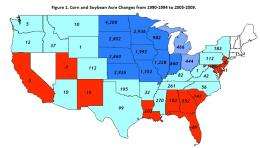Changes in crops acres since freedom to farm

The 1996 U.S. Farm Bill eliminated many acreage restrictions, thereby allowing farmers to plant what they believe to be their most competitive crops. A study conducted by University of Illinois agricultural economists evaluated subsequent acreage changes across crops to better understand which crops have been most profitable during a period when farm legislation contains few acreage constraints.
"Since the passing of the Freedom to Farm Act, soybean and corn acreages have increased significantly," said U of I agricultural economist Gary Schnitkey. "Crops losing acres include wheat, barley, grain sorghum, corn silage, cotton, peanuts, dry edible beans, and potatoes."
To evaluate acreage changes, data detailing annually harvested crop acres in the United States was obtained from the National Agricultural Statistical Service, an agency of the U.S. Department of Agriculture. Data was collected for all crops with over 1 million acres harvested in 2008. There were 13 crops identified, including soybeans, corn for grain, hay, rice, wheat, barley, grain sorghum, corn for silage, cotton, peanuts, dry edible beans, potatoes, and sugar beets.
For the study, harvested crop acres were averaged for 1990 through 1994, the years preceding the Freedom to Farm Act, and for 2005 through 2009, following the passing of the legislation.
"From the early 1990s to the late 2000s, soybeans were identified as the crop with the largest acreage increase," Schnitkey said.
Soybeans averaged 58.2 million acres harvested per year from 1990 to 1994, increasing to an average of 72.2 million acres from 2005 to 2009. This 14.0 million acre increase represents a 24 percent expansion in soybean acres.
"Corn also had a sizable increase of 9.4 million acres, or a 14 percent expansion in corn acres," he said.
Soybean and corn acreage growth was concentrated in the Great Plains and the greater Corn Belt. North Dakota had the greatest combined acreage change with a 4.2 million acre increase in its soybean and corn acres. U.S. states with a 2 million acre or greater increase in soybean and corn acreage include Minnesota, Kansas, Nebraska, and South Dakota. States with a 1 to 2 million acre increase include Iowa, Missouri, Illinois, and Wisconsin. States with between a 0.4 and 1 million acre increase include Michigan and Ohio.
According to Schnitkey, two of the 13 crops have kept relatively stable in their acreage. These include hay, averaging about 60 million acres, and rice, averaging about 3 million acres. The remaining nine crops had sizable acreage reductions.
"Wheat had the largest reduction in acreage following the passing of the Freedom to Farm Act, dropping from 62.8 million to 50.7 million acres," Schnitkey said. "This 12.1 million acre decrease represents a 19 percent decline in wheat harvested.
Other crops losing 1 million acres or more are barley with minus 4.0 million acres, grain sorghum with minus 3.7 million acres, corn for silage with minus 3.7 million acres, and cotton with minus 1.9 million acres.
"For states with large soybean and corn acreage increases, the crops losing acres did not balance out these gains," Schnitkey said. "In Illinois, for example, acreage changes in the 13 crops resulted in a positive 0.3 million acres. This means that 0.3 million acres came from some other source, most likely pasture acres.
"A number of reasons could be given for the large gains in U.S. soybean and corn acres. On the supply side, these crops have had larger yield increases and a greater number of biotechnology varieties and hybrids offered than other crops. On the demand side, new uses for soybeans and corn account for some of the acreage changes, with biofuels being a major new use of corn."
Provided by University of Illinois at Urbana-Champaign















